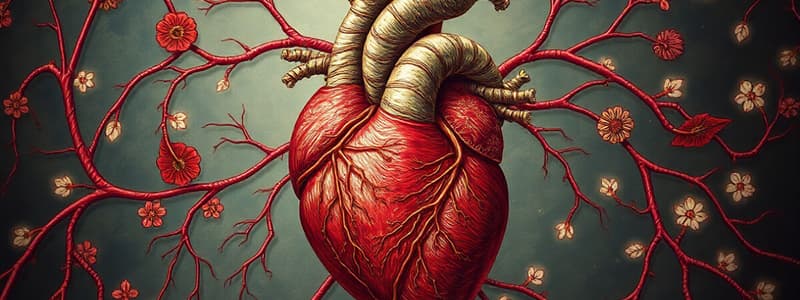Podcast
Questions and Answers
What is the primary function of the circulatory system?
What is the primary function of the circulatory system?
- To produce hormones
- To transport substances throughout the body (correct)
- To facilitate breathing
- To protect against infections
Blood is a type of epithelial tissue.
Blood is a type of epithelial tissue.
False (B)
What type of tissue lines the blood vessels and the heart?
What type of tissue lines the blood vessels and the heart?
epithelial tissue
The heart is a large __________.
The heart is a large __________.
Which blood component is responsible for transporting oxygen?
Which blood component is responsible for transporting oxygen?
Match the following components of blood with their functions:
Match the following components of blood with their functions:
Platelets make up __________ of your blood volume.
Platelets make up __________ of your blood volume.
The heart has nerve tissue connected to it that stimulates contraction.
The heart has nerve tissue connected to it that stimulates contraction.
Name one waste product that blood transports out of the body.
Name one waste product that blood transports out of the body.
What percentage of your blood is made up of white blood cells?
What percentage of your blood is made up of white blood cells?
Flashcards
What is the function of the circulatory system?
What is the function of the circulatory system?
The circulatory system is responsible for transporting vital substances throughout the body, connecting all organs and tissues.
What are the main components of the circulatory system?
What are the main components of the circulatory system?
It consists of the heart, blood, and blood vessels, working together as a coordinated unit to transport essential substances throughout the body.
What types of tissues are present in the circulatory system?
What types of tissues are present in the circulatory system?
The circulatory system comprises all four types of tissues, including connective tissue in blood and heart valves, epithelial tissue lining vessels and the heart, muscle tissue in the heart, and nerve tissue controlling heart contractions.
What is the most abundant type of blood cell?
What is the most abundant type of blood cell?
Signup and view all the flashcards
What is hemoglobin and what is its role?
What is hemoglobin and what is its role?
Signup and view all the flashcards
What is the function of red blood cells in gas exchange?
What is the function of red blood cells in gas exchange?
Signup and view all the flashcards
What are white blood cells and what is their function?
What are white blood cells and what is their function?
Signup and view all the flashcards
What are macrophages and what is their role?
What are macrophages and what is their role?
Signup and view all the flashcards
What are lymphocytes and what do they do?
What are lymphocytes and what do they do?
Signup and view all the flashcards
What are platelets and what is their role?
What are platelets and what is their role?
Signup and view all the flashcards
Study Notes
The Circulatory System
- The circulatory system is the organ system responsible for transporting substances throughout the body.
- The circulatory system comprises blood, the heart, and blood vessels.
- The circulatory system contains four types of tissue: connective, epithelial, cardiac muscle, and nerve tissue.
- Blood vessels include arteries, veins, and capillaries.
- Arteries carry blood away from the heart under high pressure.
- The walls of arteries are thick and muscular to withstand this pressure.
- Veins carry blood toward the heart.
- Capillaries are small blood vessels with very thin walls allowing for material exchange. Blood cells pass through one cell at a time.
- Blood is a connective tissue that circulates throughout the body.
- Blood transports oxygen, nutrients, heat energy, carbon dioxide, hormones, and waste.
- Blood is made up of:
- Red blood cells (45% of blood): contain hemoglobin with 4 sites for oxygen and carbon dioxide attachment. Oxygen is transported from the lungs to tissues, and carbon dioxide is transported from tissues to the lungs.
- White blood cells (1% of blood): include macrophages that can "eat" infections, and lymphocytes that produce antibodies that can attach to and destroy infections.
- Platelets (<1% of blood): Essential for blood clotting.
- Plasma (55% of blood): the liquid portion of blood, rich in protein, controls blood volume and blood pressure and carries dissolved minerals, nutrients, and wastes.
- The heart contains cardiac muscle tissue, nerve tissue, and connective tissue.
- The heart is divided into four chambers: right and left atria, right and left ventricles.
- Blood flows from the body, to the heart, to the lungs, and back to the body.
- The heart pumps blood throughout the body in a continuous cycle.
Studying That Suits You
Use AI to generate personalized quizzes and flashcards to suit your learning preferences.




